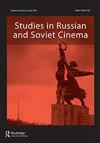Haptic visuality, sensation and politics in Eisenstein’s film theory
IF 0.4
0 FILM, RADIO, TELEVISION
引用次数: 0
Abstract
ABSTRACT In this article, I analyse the convergences between haptic visuality and Sergei Eisenstein’s film theory, in particular his ideas on rhythm, sensorial thought, organic unity, pathos and ecstasy in order to consider the extent to which they constitute the core of a ‘cinema of sensation’ that, for Eisenstein, serves a very important political drive. Simultaneously positioned at the core of avant-garde criticism of traditional models of representation on the one hand, and political revolutionary ideas on the other, cinema appears, to Eisenstein, as a privileged space in which to bring the representative imagery dominant in ‘bourgeois societies’ into question and to put art at the service of the Revolution. My intent is to assess how Eisenstein combines avant-garde aesthetic aims and experimental film practices with the goals of politically engaged creations. This combination is achieved through the exploration of a haptic use of images that prefigure a ‘cinema of sensation’. This article therefore takes the form of a double analysis: on the one hand, it examines the relationship between haptic visuality and Eisenstein’s film theories; on the other, it questions how haptic visuality plays a fundamental role in harmonising the apparently opposite vectors of aesthetic avant-garde and materialistic political drives.爱森斯坦电影理论中的触觉、视觉、感觉和政治
摘要在这篇文章中,我分析了触觉视觉与谢尔盖·艾森斯坦电影理论之间的趋同,特别是他关于节奏、感官思维、有机统一、悲情和狂喜的思想,以考虑它们在多大程度上构成了“感觉电影”的核心,对爱森斯坦来说,这是一种非常重要的政治驱动。在爱森斯坦看来,电影同时处于对传统表现模式和政治革命思想的先锋批评的核心,是一个特权空间,在这个空间里,人们可以质疑“资产阶级社会”中占主导地位的代表性形象,并将艺术为革命服务。我的目的是评估爱森斯坦如何将先锋美学目标和实验性电影实践与政治创作的目标相结合。这种结合是通过探索图像的触觉使用来实现的,这些图像预示着“感觉的电影”。因此,本文采取了双重分析的形式:一方面,它考察了触觉视觉性与爱森斯坦电影理论之间的关系;另一方面,它质疑触觉视觉如何在协调美学先锋派和物质主义政治驱动的明显相反的载体方面发挥根本作用。
本文章由计算机程序翻译,如有差异,请以英文原文为准。
求助全文
约1分钟内获得全文
求助全文

 求助内容:
求助内容: 应助结果提醒方式:
应助结果提醒方式:


